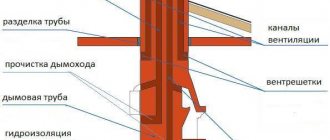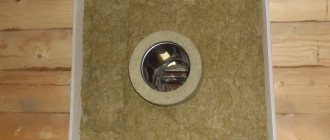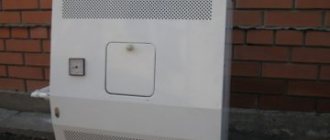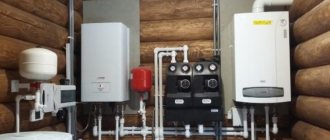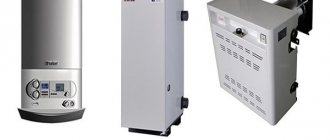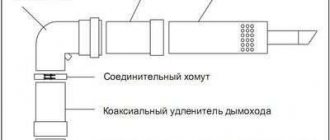Any stove, if used incorrectly, poses a fire hazard, so it is important to promptly service the system and comply with all operating requirements. Most often, people wonder how to clean a chimney pipe from soot in a private house. A clogged lumen impairs draft, which leads to problems with heating and a burning smell in the room.
Why do blockages occur?
The main factor in the formation of plugs in chimneys is emissions from burning wood. Typically, pipes become clogged with soot, tar and carbon monoxide. To reduce the amount of combustion by-products, you need to take a responsible approach to the selection of firewood and know about its characteristics.
Thus, coniferous trees produce a larger amount of resins, but produce less heat. Therefore, they are of little use for space heating. The resin, when released from the firewood, settles on the inner walls of the stove, to which a layer of soot adheres on top.
Also an excellent dirt collector is condensation formed when using undried firewood. It is worth noting that many owners burn household waste in stoves, the waste from which also reduces the clearance in the pipe.
There are also other ways of clogging. For example, in the fall, tree leaves and other debris often get inside. In addition, a layer of soot sometimes flakes off and falls down, blocking the passage.
Cleaning if the pipe lumen is completely blocked
To do this, pour water (about three liters) into the chimney from above. After this, steam is released, which cleans the hole in the pipe. Soot flies out of the chimney in a compacted cloud of thick consistency. To prevent a chimney made of steel from rusting, they immediately begin to heat it and warm it up until the last moisture evaporates.
There are special cleaning logs or pellets , which are placed in the stove without opening the packaging, and the combustion lasts for about two hours. After this, the accumulation of soot and soot in the channel becomes loose, the separated light particles rise, and the heavy ones fall down into the firebox.
If special inspection holes are provided along the chimney, it is recommended to carry out preventive cleaning after using cleaning logs. There are special powders for cleaning the furnace outlet channel, for example, a Czech product called Kominichek, Smoke-Glas and others.
For their use instructions have been developed that will tell you how to use them correctly and what dosage to use. But all of them are used in the furnace to produce a chemical reaction, which results in substances that destroy the soot layer in the pipe.
In conclusion, it should be said that the smoke duct should be cleaned in any case, so that the misfortune of poor combustion of the stove is not added to the grief of sudden smoke in the room or a fire in the attic, where a pipe clogged with soot passes through.
Damage from a clogged chimney
A dirty chimney not only impairs draft and complicates kindling. It can be fraught with many dangers that cause harm to health and property. The main threats are:
- Due to poor breathability, smoke returns into the room, which can cause carbon monoxide poisoning.
- A clogged passage quickly collects combustion products on its walls, and poor draft promotes the formation of condensation, which leads to even faster clogging.
- The soot layer is considered excellent thermal insulation and prevents the main elements of the stove from warming up, which significantly reduces heating efficiency.
- Plaque often ignites when heated, which can lead to a fire and rapid burning of pipe walls. Sparks flying out pose a threat to neighboring buildings.
All these situations cause a lot of trouble for the user. That is why you need to be responsible when servicing chimneys.
Why clean the chimney?
Everyone knows that soot accumulates in the chimney and needs to be cleaned regularly. It's not just about aesthetics. If there is poor draft in the pipe, smoke accumulates there. It contains dozens of toxins and harmful substances, which makes the smoke poisonous. Once in a room, it can penetrate the human respiratory tract and cause various respiratory diseases.
If there is a lot of it and the incident happens at night, there is a risk of dying from suffocation right in your bed. The danger lies not only in this. As it settles on the walls of the chimney, soot sticks firmly to it due to the remaining oil that entered the chimney along with the smoke. Essential oil is found in almost every type of firewood, most of it in coniferous trees.
When fuel is selected taking into account its price, there is no need to talk about quality. An uncleaned chimney heats up the smoke, and the heat can cause soot to ignite. In flakes, burning soot flying out of the chimney can set fire to dry leaves that have fallen onto the roof with the wind or cause fires in wooden buildings that are nearby. Fruit trees in the area may also be damaged.
Over time, the pipe may crack due to high heat. Through the cracks, toxic smoke will enter the attic and enter the house. Saving on chimney cleaning is not a very wise decision. When there is no money, call specialists, you can do the work yourself. One of the methods should help to cope with the problem. If this does not happen, you should not hesitate to call the experts.
When to Clean
It is not always possible to quickly clear a heavily clogged channel. Often, for these purposes, it is necessary to hire specialists who will perform all this work efficiently, carefully and accurately. So that you do not have to replace the pipes with new ones, it is recommended to regularly inspect the entire system and carry out timely preventive maintenance.
It is imperative to check the channel when installing new equipment or at the beginning of a cold period. The stove must be inspected at least 2 times a year. After several years of operation, the inspection can be carried out once.
Brick systems clog more often, so they are checked 3 times: before the onset of cold weather, during and after it. If the heating unit is used constantly, then it must be checked at least once every 2 months.
Ferrum stainless steel chimneys prevent the accumulation of soot due to the smoothness of the internal surface and the smoothness of the joints of the bell system. Caring for it will be much easier and will cost much less.
Frequency of events
Backdraft is one of the signs indicating the need for chimney cleaning
It is recommended to clean it once a year in the spring at the end of the boiler’s operation, if it is heated in accordance with the instructions.
The timing of chimney cleaning is influenced by the following factors:
- Date of the last procedure, how it was performed and what the degree of contamination was.
- Channel configuration. Number of knees and contours.
- Pipe material. Smoothness of internal walls.
- The fuel used is coal and raw wood.
- Has the oven been used to recycle paper, plastic and synthetic fabrics?
The following signs indicate the need to clean the chimney:
- Reduced cravings. Smoke leaking into the room.
- Changing the color of the flame in the firebox from bright orange to red.
- Emission of thick black smoke.
- The appearance of a large amount of dust on the floor, things, and interior items.
- Characteristic odor of creosote.
You can check the condition of the pipe visually using a flashlight. To do this you will have to climb onto the roof. If the chimney has bends, a load falls inside. The level of pollution is calculated by how freely it moves.
Tool for the job
In order to clean the roof, a special device is used, consisting of a long rope with a brush attached to it. To make it more convenient to work with such a device, a weight is attached to the end that will pull the brush down. In addition, the weight helps to break through a strong blockage if you hit it from above several times.
The shape of the brush should be selected depending on the type of pipe. It is strictly forbidden to use metal pile on stainless steel walls.
Why does the chimney become clogged?
A clogged chimney occurs for a number of reasons. Often the culprit may be a foreign object getting into the pipe. For example, birds or other animals that bring with them nesting material that completely blocks the smoke escape. Excessive soot accumulation (a natural byproduct of the combustion process) can also cause blockages. Finally, large amounts of leaves, branches and other debris can block the chimney vent.
Sometimes incorrect design during construction can cause further frequent blockages. This is the most difficult reason to eliminate, since in most cases it will not be possible to get rid of it on your own, and contacting qualified specialists can cost a lot of money. Often, to completely eliminate the problem, it is necessary to completely dismantle the stove or fireplace in order to build a new firebox and smoke exhaust system. If you do not have the relevant experience and do not know how to clean a chimney, under no circumstances try to do it yourself.
Cleaning from the roof
Cleaning with a brush is performed by a professional in several stages:
- Before starting work, all doors in the furnace are closed so that soot does not stain the room. For greater effectiveness, you can cover them with a wet cloth. Specialists wear safety glasses to prevent waste from getting into their eyes, and they also attach a safety rope, which eliminates the possibility of injury in the event of a fall.
- The first step is to remove the pipe head and inspect the channel.
- After this, the chimney sweep is carried out with a load without a brush along the entire length to chip off the layers.
- Then a brush is put on the instrument and the walls are thoroughly cleaned with forward movements to the entire depth of the canal.
- During operation, the inspection hatches are opened several times and the space is cleared of accumulated soot.
This is a very effective cleaning method that has been used for many centuries. However, this method has a serious drawback: the brush does not pass through areas where the channel is turned at a right angle.
Special cases of chimney cleaning
Some chimney cleaning situations require separate consideration.
How to clean a chimney pipe in a private house
The entire process of cleaning a chimney has already been briefly described above. To what has been said, you only need to add that if the smoke channel is severely clogged, the first operation is to punch through the carbon deposits with a core without additional devices. Only after this are brushes of different sizes and designs used sequentially.
When performing work, care should be taken to create safe working conditions.
When working at height, be sure to wear a safety rope
Indoor cleaning
How to clean a chimney in a stove from soot in hard-to-reach places in the channel? If the stove has the correct design, it has special hatches through which you can easily clean all sections of the pipe. To do this, use a brush on a rigid bending rod.
For small sections, use a cleaning brush, sold in specialty stores. They are also suitable for cleaning drains and ventilation systems.
For greater cleaning depth, special prefabricated rods made from several parts are used. They are usually attached to each other using threads and have a length of 1 m.
The higher your budget, the more professional equipment you can order. For example, a professional flexible rod wound on a special drum, along its entire length there are indicators that allow you to control the depth of the brush.
After completing the work, it is recommended to wait about half an hour for the plaque to settle, and then clean all hatches. At the end of the procedure, the pipe head must be closed.
Mechanical and manual cleaning
For mechanical cleaning of chimneys today, the same tools are used as 200 years ago. The technology itself has also not undergone major changes. Cleaning is carried out from the roof side and from the stove side.
Tools and materials
To clean the roof side use:
- rope or steel cable;
- hard metal brushes and weights;
It is important that the load has the correct center of gravity. Otherwise it may get stuck. It is ideal to use a round metal core as a load. It is they who break through the blockage. And only then do the brushes come into use.
If you don’t have a suitable brush at hand, you can make one yourself from an old plastic bottle. Step by step instructions below.
How to make a ruff with your own hands?
- Take a plastic bottle and cut 150 mm from the top. Make cuts along the top part in 15 mm increments. The length of the cut is selected depending on the diameter of the pipe. If the pipe diameter is 100 mm, then the brush diameter should be 130 - 140 mm.
- Drill a hole in the center of the plug. Screw the plug into place and bend the petals.
- The first brush is ready. Now we do the second one in exactly the same way.
- Find a suitable load. Its weight should be sufficient for the brush to pass through the chimney.
- Tie the load to a strong cord or steel cable. Thread the other end of the cord into the brush plugs. The brushes should be positioned towards each other.
- Take the rest of the bottle. Cut off the bottom. It turns out to be a cylinder. Cut it lengthwise. Insert it between the brushes. The length of the cylinder should be about 150 mm. Give it a diameter equal to half the diameter of the brush. Secure with a stapler.
- Tie a knot over the top brush plug. The tool is ready.
The process of making a brush with your own hands
There is another option for making a brush with your own hands:
DIY brush in the form of a brush
Roof side cleaning
The whole process consists of 6 stages:
- Prevent soot from entering the room. To do this, cover the firebox with a wet cloth and close all hatches.
- Prepare in advance and use all necessary equipment for its intended purpose, comply with all safety requirements when working at height. You will need: safety glasses, closed non-slip shoes, gloves, insurance. It is prohibited to carry out work in rain or strong wind. And also under the influence of drugs, alcohol and other drugs.
- Remove the head and inspect the channel. If necessary, remove debris with a broom.
- The first pass is made using a weight. It will clean the chimney from large contaminants.
- After this, install the brushes and clean the channel walls from soot. There's no need to rush. This is not a difficult process, but it is a messy and time-consuming process.
- The last stage is cleaning the inspection chambers.
Cleaning the chimney from the stove side
The previous method will allow you to clean the channel only up to the first turn. Another tool will help you further clean the stove from soot without disassembling it. You can't use gravity.
The oven must have special hatches for cleaning. To do this, use another tool. A special brush with a rigid but flexible fiberglass cable will help you clean an area 3–5 m long. This set is sold in hardware stores.
There is also a more specific tool:
Chimney cleaning tool
This device allows you to clean a longer area. It is easiest to clean the external chimney. But only if it is assembled correctly.
Step-by-step instruction:
- Unscrew the plug. Clean it from dirt, grime and debris.
- If the pipe is made of stainless steel, then using a metal brush is strictly prohibited.
- We attach a suitable brush and perform cleaning, gradually moving the brush upward.
- The firebox itself is cleaned in the same way. The flexible but rigid support allows you to push the brush far enough.
- The collected soot is removed. And they carry out minor chimney repairs. It is important to remember to replace the pipe head.
Chemical methods
Traditional methods of cleaning chimneys are effective, but it is a very labor-intensive process that takes a lot of time. If you are thinking about how to clean the chimney in a stove at home without unnecessary hassle, then specialists who use substances that break down soot will come to your aid. However, even they are not always able to cope with severe contamination, so preventive cleaning is necessary.
The products have different compositions, but they are all aimed at detaching carbon deposits from the walls and making it difficult for new plaque to appear. Let's look at the most common methods.
Smoke
Available in several versions:
- Cardboard box - set on fire in the firebox. The preparation contains special substances that dissolve combustion products adhering to the pipe. After which the soot falls or goes away along with the smoke. After the box burns out, the effect will persist for a long time.
- Wooden burning "Smoke" - is burned in the stove and also cleans the chimney. At the same time, the components contained in the product produce a beautiful flame that looks impressive in the fireplace.
- Cleaner for pallet stoves - perfectly cleans boilers and stoves of this type. It can also be used for wood-burning fireplaces. The product can be used once every 2 months, strictly following the instructions.
HANSA
This is a series of high-tech products from a German manufacturer. They are aimed at dissolving creosote, which is a binding material for combustion products. The soot layer crumbles and burns entirely in the firebox.
Similar products are produced in Russia under the name “Chimney Sweep”. It also comes in a variety of forms and can be used for both cleaning and preventing contamination. The great advantage of such products is the ability to use them in chimneys of the most complex design; they do an excellent job of cleaning stone pipes that have an uneven and porous surface.
Kominichek
This product is produced in the Czech Republic and is very popular in our country. It is packaged in small bags, which are burned along with firewood. Thanks to the presence of special substances, soot is converted into a substance that quickly burns when the furnace heats up. It should be noted that this composition is not effective in case of heavy contamination, and during combustion it releases toxic substances, so it is necessary to tightly close the firebox when using it.
Other chemical cleaning products are also commercially available. It is recommended to try different options and choose the best one for yourself.
What are the methods for cleaning a chimney?
To clean a chimney pipe, you can resort to several methods:
- folk remedies;
- use modern chemicals;
- ignite the chimney;
- mechanically remove soot deposits.
Using the first three methods, you can clean channels that have a slight degree of contamination. But if the walls of the chimney are overgrown with soot, then the mechanical method will be just right. The first two ways to clean the channel are to place a chemical or folk remedy and set it on fire.
Substances released during combustion actively decompose pollution. Some of the soot in the form of flakes escapes from the pipe and falls down onto the courtyard, the rest falls down to the channel bottom. Although calcining a chimney
Calcination is the burning of soot in a chimney due to the high combustion temperature. To do this, the furnace or boiler must be forced to operate at full power, which is ensured by supplying the greatest amount of oxygen. After heating, gases heated to a temperature of 600ºC cause soot to burn in the chimney and clean it.
The method requires a preliminary check of the integrity of the smoke channel , which can collapse over time; even simple rodents can make a contribution. Fire hazardous materials may ignite through openings.
Mechanical way to clean a chimney duct
This difficult task will become simple if you familiarize yourself with the information presented in this article. Before cleaning the stove, you should remove from the firebox all items that are poorly secured and may interfere. The stove and hob, if any, are covered with thick cellophane or cloth and secured with a weight.
You need to start cleaning the chimney from the bottom; for this, use special brushes and brooms . After freeing the accessible part of the pipe, clean the chimney from the roof side. To do this, you need to secure yourself with a mounting belt, and using a sinker, try to push or pull out the layers of soot in or out.
If a lot of debris and soot accumulates in front of the stove, you can get rid of it with a vacuum cleaner or a broom and dustpan. This type of work is usually performed by men, as it requires some effort.
Soot can be considered the main enemy of a chimney; it reduces draft and gradually destroys the pipe. If soot begins to burn, then not all channel materials can withstand such heat.
Chimney cleaning with potato peelings
To clean the oven in this way, it is melted, then potato peelings are placed on the fire. The peel is pre-dried so that it burns well in the oven. The cleanings are placed in a container the size of a bucket and kept for several days. After this cleaning is ready for use in the form of a cleanser.
During combustion, cleaning products release starch, which destroys soot upon contact with it. If the work is done correctly, then within a few days the soot will fall out of the chimney in pieces, falling into the firebox. To clean the chimney faster, you can use mechanical cleaning items.
Using salt to get rid of soot
This method is more suitable as a preventive method for removing soot deposits, which it is advisable to use constantly. Salt is poured in an amount depending on the size of the stove onto the hot fuel.
When burning, salt particles will react with oxygen molecules and destroy the soot in the pipe . The effectiveness of the measures taken depends on the choice of salt quality, but you can choose the right substance by trying this cleaning several times.
Folk remedies
It should be noted that chemical methods are not new. For a long time, folk remedies have been used for cleaning, which also cope well with pollution.
The easiest way is ordinary table salt, which is sold in any grocery store. Its vapors destroy the structure of sooty growths. All you need to do is sprinkle some of the product on the wood and set it on fire. This method is effective for prevention, but it is ineffective for large growths.
Naphthalene has the same effect, one tablet of which is quite enough for preventive work. However, this method is rarely used due to the formation of an unpleasant odor when burning naphthalene.
You can pour several liters of boiling water into the pipe before lighting. This will soften the soot, which will fall and burn when heated.
Our ancestors also used potatoes to get rid of soot accumulation by simply throwing them into a hot oven. Starch softens the plaque, which will simplify further cleaning if it does not fall off on its own.
For a long time, people have been using a mixture of copper sulfate, burnt coal and saltpeter for dry cleaning. Typically, for these purposes, components are taken in a ratio of 5x2x7.
The mixture consumption is small. Approximately 5 kg of firewood requires 1 kg of product, which is poured into a hot firebox. This composition is toxic, so you need to close the stove door tightly.
It is effective to use alder or aspen firewood for such purposes. The emissions from their combustion make it possible to effectively separate the plaque layer from the internal part. In extreme heat they are removed through a pipe.
Few people store such firewood due to low heat transfer. They are ineffective for heating a room, but it is recommended to keep them in stock for cleaning. Sometimes, as a preventative measure, it is enough to burn several of these logs to keep the chimney in order without any extra effort.
Useful tips
There are certain rules for using a stove or fireplace that help extend their full service life.
- Do not use firewood obtained from coniferous trees as fuel. The reason for this is the high content of resin in them, deposits of which remain on the walls of the chimney.
- Do not burn a stove or fireplace with damp wood or firewood from recently fallen trees. High humidity contributes to increased deposits of soot and water vapor.
- Do not burn various types of garbage. This is especially true for products made of plastic and other synthetic materials. Objects intended for this purpose must be used as fuel.
- Among all types of firewood, the best option for heating is dry deciduous firewood. After heating, it is advisable to additionally burn a small amount of aspen wood. They help burn soot out of the chimney.
Now you know the main options for cleaning chimney pipes. It should be remembered that additional inspection is necessary during such work. And we shouldn’t forget about prevention.
How to clean a chimney in a stainless steel stove
Stainless steel pipes are durable and resistant to contamination. Condensation does not linger on such a surface, but flows into a special receiver, from where it is drained when filling. This reduces the accumulation of soot, and the accumulated layer is much easier to clean than in other types.
Cleaning stainless steel pipes has its own characteristics. As mentioned above, they should not be cleaned with metal brushes, which disrupt the smoothness of the surface, which contributes to the formation of soot.
The procedure is carried out as follows:
- A brush on a flexible rod is inserted into the hole, with which the canal is cleaned. It is convenient to use a drill with a special attachment for these purposes. Gradually, as you move inside the canal, the length of the rod increases.
- If a coating that is difficult to remove has formed on the surface, the pipe is dismantled, after which it must be calcined with a blowtorch. If high-quality stainless steel was used in production, during this procedure the product will retain its original appearance.
The quality of the chimney components is very easy to check. If the component is not attracted by a magnet, then you have a chimney that can be safely cleaned with a blowtorch.
Sandwich pipes require cleaning even less often, but if the need arises, you can use a brush with an extended rod mounted on a drill.
Cleaning quality control
After cleaning, you need to check the chimney by shining a flashlight on it.
After cleaning the pipe, you need to ensure the quality of the result achieved. Otherwise, undesirable phenomena and repeated operation may occur after the heating system has cooled down.
You can check the condition of the chimney in the following ways:
- Visually. The method is only suitable for straight channels without bends or turns. You will need a powerful flashlight that creates a bright beam.
- A round and heavy object, 2-3 cm smaller in diameter than a pipe. This could be a weight, a medicine ball, a ball filled with water, or other objects. The quality of cleaning is determined by how freely the object slides through the channel.
- Test fire. An old newspaper is enough to determine the traction force. If the thing being burned burns quickly and the process is accompanied by a characteristic roar, the purpose of cleaning has been achieved.
You can attach a sheet of paper to the firebox opening. If it presses tightly against it and then pulls in, the job is done perfectly.
Cleaning Frequency
For preventive purposes, experts strongly recommend inspecting and visually inspecting stoves, solid fuel boilers, fireplaces and chimney ducts.
Schedule of planned audits:
- any heating equipment - after initial installation in a residential area, immediately before start-up, after completion of repair work;
- seasonal operation systems - before the start and at the end of intensive operation;
- gas boilers and stoves - twice a year in the first 2 years after installation/laying, then once annually;
- brick chimneys - quarterly;
- chimneys made of any other materials - every 12 months;
- outlet pipes of heating and heating-cooking furnaces - three times per season.
If problems are identified during the inspection, they must be corrected immediately. Then the system will function correctly and provide the proper level of comfort and fire safety in residential premises.
Cleaning the chimney is mandatory as soon as possible, if it has lost its capacity and becomes clogged, combustion products do not escape into the atmosphere, but return to the living rooms
You can organize cleaning activities yourself or use the services of a chimney sweep. The main thing is to correct all problems in a timely manner and ensure that the equipment can operate in normal mode.
How to clean the inside?
Many people are interested in knowing how to clean a stove pipe when it is not possible to get to it on the roof. Suitable for cleaning the inside of a house or bathhouse. For this purpose, devices have been developed - brushes on flexible rods. You can also buy them in construction markets.
Experts sometimes use a vacuum cleaner to clean the stove. It is better not to try this on your own: standard home vacuum cleaners will not help here. They have little traction and, in addition, soot in them can cause an electrical appliance to catch fire.
Getting to the chimney to clean the fireplace portal without disassembling it is quite simple. When cleaning a stove or boiler is required, you must first remove the glass collecting condensate from the pipe. Through this hole you can insert a brush into the pipeline and clean it by moving it back and forth. Soot and dirt will fly down and be ventilated out through the hole in the pipeline. The work is dusty, so you should wear a protective mask, respirator, suit and gloves when cleaning.
On a note!
When there are no condenser cups or service hatches, you can do without disassembling the smoke exhaust system. You can clean it using traditional methods.
Sequence of mechanical cleaning
- The oven doors must be tightly closed to prevent soot from falling out.
- If deposits in the fireplace are being removed, a damp cloth must be placed on the combustion chamber.
- To make the channel cross-section larger, you need to open all existing dampers.
- A safety belt must be placed on the body and secured well.
- The chimney is inspected on the roof. If the thickness of the soot layer is less than 2 mm, it is removed using chemicals. The garbage is simply pushed down.
- The header is removed. Use a stiff brush or scraper to remove all layers.
- Cleaning hard-to-reach places is done using a flexible brush. You can also use a cable that has a special attachment at the end. With each turn of the handle, the device moves downward.
- By moving the suspended metal ball, you can remove a layer of soot and other large blockages. Work must be carried out carefully so as not to damage the integrity of the brickwork.
- After opening the chimney door, the soot layer is completely removed.
- The blower and combustion chamber are cleaned.
If plaque is removed in an open-type fireplace, the treatment is performed with a metal brush from the side of the firebox.
Upon completion of the procedure, it is necessary to light the stove to check the draft. The head is then installed in place.
Prevention
Without preventative maintenance, it is impossible to achieve proper operation of the furnace. The reasons for frequent blockage of the smoke channel with soot and other contaminants are:
- use of raw firewood;
- burning plastic waste, PE, chipboard and plywood residues in a stove;
- lack of traction;
- use of spruce or pine firewood.
The best way to clean it is to follow the recommendations for using the heating system. It is important to dry the firewood well before putting it into the firebox: this way, even resinous types of wood will not cause serious harm. Do not heat with plywood boards and other building materials containing glue or varnished ones. Such residues should only be thrown into a landfill, and not burned at home.
By listening to the recommendations of specialists, you can forget about cleaning for at least six months. Today it is not necessary to call a chimney sweep and pay him. By using one of the pipe cleaning methods, you can both save money and keep your stove in order.
How can you control the quality of the procedure?
Many people are skeptical about cleaning smoke exhaust ducts using chemical methods. They believe that such soot removal cannot compare with the work of a professional chimney sweep.
Upon completion of the procedure, all masters check the quality of the manipulations performed. They analyze the general condition of the cleaned pipe device. For this purpose, various tools are used, for example, quite often a mirror comes to the rescue.
Large companies providing services in this area, as well as various service centers, use video cameras equipped with a special backlight function to monitor the quality of work. Such a device helps to give an accurate assessment of the quality of the work done and see in which places the soot could not be removed.
How to clean mechanically
Before cleaning the chimney pipe of dirt, it is important to evaluate the quality of the roof and the reliability of the chimney. If it is located low above the roof or a ladder can be placed nearby, cleaning can be carried out directly from the roof, through the upper part of the chimney. For this:
- take a special brush;
- suspended on a rope;
- put into a pipe;
- begin to move it up and down, removing accumulated soot.
During mechanical cleaning, the main contaminants will fall down, but something will also fly through the top. Therefore, before cleaning, it is recommended to wear protective clothing, gloves, goggles and a respirator. Gloves will also protect your hands from cuts from the rope.
On a note!
To collect everything that has poured down the pipe, you should place a bucket or any other container below. An assistant who promptly empties what you have collected will also be beneficial.
Devices for cleaning the chimney can be purchased at hardware stores and specialized sales points for stove products. If you want to make a cleaner yourself, you should attach a centered metal ball to the cleaning brush. This way the cable will pass through the chimney more easily and the quality of cleaning will improve significantly. It is not recommended to use dumbbells or wrenches as an alternative. These parts can clog the pipe by simply getting stuck in it, and then it will be necessary to disassemble the chimney, and no one needs this. Videos on how to clean a pipe can be found on the Internet.
How to blow out a chimney yourself with air
Another option for cleaning the vertical channel from accumulated soot is to blow it with a powerful air stream. To do this, it is necessary to create a turbulent flow in the device, which, under high pressure, will blow all the dirt out of it. This work can only be done with a very powerful fan.
You can use a regular chainsaw as an air blower. The flow of the gas mixture must be drawn outward by the device.
This technique does not remove all deposits. Heavy deposits can only be cleaned mechanically.
